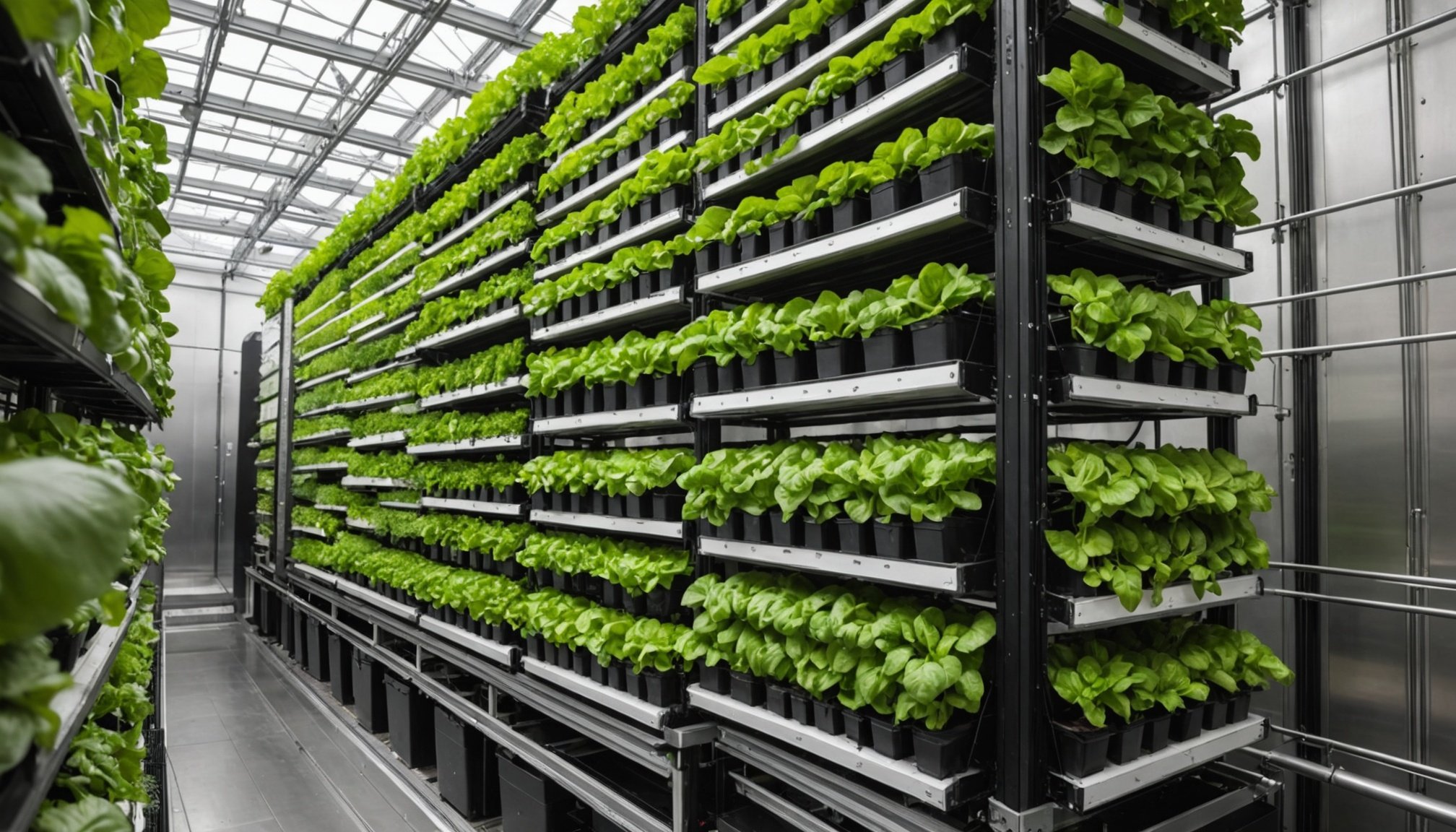Understanding Vertical Farming
Vertical farming is an innovative approach to agriculture, focusing on growing crops in stacked layers within controlled environments. This method contrasts traditional farming, which relies on expansive lands and open fields. By utilising urban spaces—such as rooftops, warehouses, and multi-story buildings—vertical farming maximises the efficient use of space, making it an appealing option for densely populated urban areas.
A core principle of vertical farming is its emphasis on sustainable practices, favouring less reliance on soil and more on hydroponics or aeroponics systems. These systems allow plants to grow in nutrient-rich water or mist, drastically reducing water usage compared to traditional methods. Additionally, vertical farms often implement advanced technology, like LED lighting and automated climate controls, to optimise growing conditions year-round.
Also read : Conquering Phobias: How Virtual Reality Exposure Therapy Transforms Fear
This urban agriculture model not only reduces the need for pesticides but also shortens the supply chain, cutting down on carbon emissions from transportation. Technologically savvy methods contribute to a more reliable and resilient local food supply. As urban populations grow, vertical farming offers a promising solution to the increasing demand for fresh produce while promoting environmental sustainability.
Benefits of Vertical Farming in Urban Environments
Vertical farming plays a pivotal role in enhancing sustainability and food supply in cities, addressing several pressing challenges associated with traditional agriculture. It bolsters local food security by enabling urban dwellers to access fresh produce close to home, reducing dependency on long supply chains. This proximity decreases transportation needs and subsequently shrinks carbon footprints related to the distribution of agricultural products.
Topic to read : Transforming stroke rehabilitation: how haptic technology accelerates patient recovery
Through strategic integration with urban biodiversity, vertical farms complement green infrastructure. They foster environments where diverse plant species flourish, contributing to healthier ecosystems. Green roofs and walls serve as habitats for species in densely populated areas, thus enriching urban life.
Reducing transportation emissions and fostering biodiversity highlights vertical farming’s capability to support holistic urban development. The integration of green infrastructure into city landscapes provides multiple environmental and social benefits. Urban planners increasingly view vertical farming as a tool for sustainable growth, recognizing its potential to reshape how cities manage food resources sustainably. As a forward-thinking agricultural model, vertical farming aligns with innovative urban policies designed to cultivate resilient, eco-friendly cities for future generations.
Case Studies of Vertical Farming Initiatives
Exploring urban farming projects offers insight into vertical farming’s practical applications and impacts. In major cities like New York, Singapore, and Tokyo, successful initiatives are transforming local food landscapes. For instance, New York’s Aerofarms utilises LED lighting and aeroponic systems to achieve a high crop yield with reduced environmental footprint, showcasing city-specific best practices.
These urban farming projects have not only improved food supply but have enhanced community engagement by creating job opportunities and educational programs. Local residents often participate in the process, fostering a deeper connection with sustainable practices and urban agriculture. Economic impacts are evident; vertical farms reduce costs associated with long-distance food transportation, thus lowering prices for consumers.
Lessons learned from both successes and setbacks guide future projects. On the downside, some initiatives faced technical and financial hurdles, impacting scalability. However, overcoming these challenges by integrating advanced technology and community-focused strategies, projects can become more sustainable and efficient. Ultimately, these case studies reveal the potential for vertical farming to revolutionise urban agriculture.
Statistical Impact of Vertical Farming on Sustainability
In exploring the sustainability statistics surrounding vertical farming, key data points highlight its profound environmental benefits. Significantly, vertical farms have been shown to reduce energy consumption through technologies like LED lighting, which can lower power requirements by up to 40%. Additionally, these farms employ innovative climate control systems, decreasing overall energy needs compared to traditional greenhouse operations.
Water usage is another critical area where vertical farming excels. On average, these systems consume up to 70% less water compared to conventional soil-based agriculture, relying on closed-loop systems to recycle water efficiently. This drastic reduction is vital, particularly in regions experiencing water scarcity, where water conservation is paramount.
In terms of carbon emissions, vertical farming diminishes the carbon footprint within agriculture by shortening supply chains and eliminating emissions tied to long-distance transportation. According to recent agriculture data, emissions per kilogram of produce in urban settings can be reduced by 50% relative to traditional farming practices. These statistics underscore vertical farming’s role in promoting an environmentally conscious model for urban agriculture, offering a compelling case for its expansion across global urban landscapes.
Expert Opinions on Vertical Farming
Experts in urban agriculture express both optimism and caution regarding the future of vertical farming. Sustainability experts emphasise its potential to address food security while reducing environmental impacts. For instance, Dr. Greenfield, an agricultural scientist, notes that vertical farming could transform urban areas into self-sufficient food hubs, particularly as technology advances.
Interviews with experts highlight the importance of continual innovation. Technology, such as AI and IoT, is pivotal in optimising sustainable practices within vertical farms. These technologies improve precision in water and nutrient delivery, cutting down waste and enhancing productivity. Despite these benefits, there are notable challenges. Experts like Professor Thomas raise ethical concerns about energy use, stressing the need for renewable resources to power vertical farms sustainably.
Ethical considerations also include the potential disruption to traditional farming communities, which may face economic challenges as urban agriculture scales up. Experts agree that collaboration between tech developers, urban planners, and policymakers is critical to navigate these issues, ensuring vertical farming contributes positively to the global agricultural future.
Challenges and Criticisms of Vertical Farming
Vertical farming presents exciting opportunities in urban agriculture but is not without its challenges. Financial barriers remain a critical obstacle for newcomers. The high initial investment requirements, especially for advanced technologies like automated systems and LED lighting, often discourage smaller enterprises. Critics argue that while sustainable practices improve efficiency, they do not always translate into financial viability, raising questions on the profitability of vertical farms in the long term.
Technical issues also persist, primarily concerning scalability. As farms expand, maintaining uniform quality and environmental conditions becomes challenging. This scalability issue is compounded by the complexity of operating sophisticated equipment, which necessitates skilled personnel, adding to operational costs. Furthermore, the efficiency of vertical farming is often scrutinised. Some critics point to the energy use of lighting and climate controls, questioning whether the environmental benefits outweigh the resource inputs required.
Market acceptance is another hurdle. Consumers accustomed to traditional agriculture might be hesitant to embrace produce from vertical farms, perceiving it as less natural. Thus, promoting widespread acceptance and understanding of such farming requires comprehensive education and effective marketing strategies.
Future Trends in Urban Vertical Farming
The future of farming is set to be deeply intertwined with advancements in vertical farming. Emerging technologies continue to transform this sector, presenting innovative solutions that boost efficiency and output. For example, the integration of artificial intelligence (AI) and Internet of Things (IoT) allows for more precise monitoring and control of growing conditions. These technologies facilitate automated adjustments to climate and lighting, minimising resource use.
Predictions for vertical farming’s role in urban planning highlight its potential as a mainstay in developing smart cities. As urban populations rise, the efficient production of local food becomes increasingly critical. Vertical farms can contribute significantly to urban self-sufficiency, fostering resilience against global supply chain disruptions.
In terms of policy, potential developments are expected to support vertical farming initiatives, encouraging investment and reducing barriers to entry. Government incentives, such as tax breaks and grants, could drive broader adoption of vertical farming practices. These trends suggest a promising trajectory, where innovation in agriculture aligns with urban planning to create sustainable, food-secure cities. As policies and technology evolve, vertical farms may become a cornerstone of future urban landscapes.






